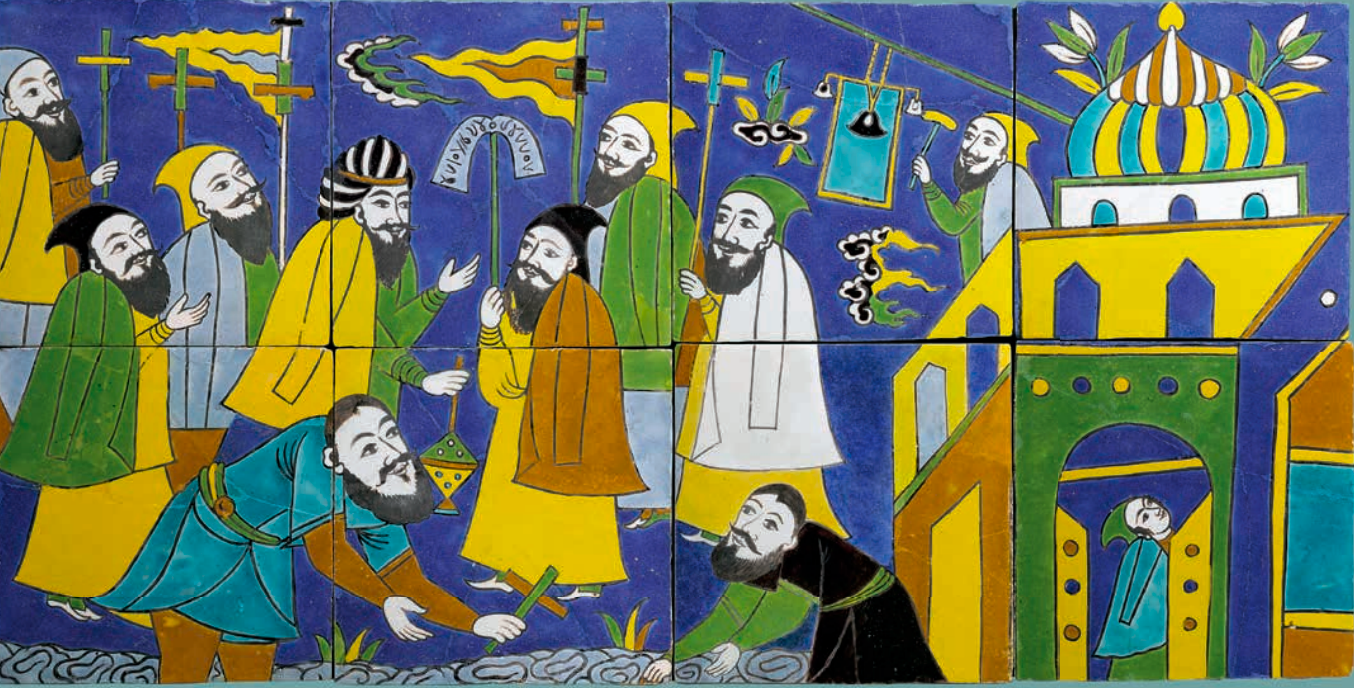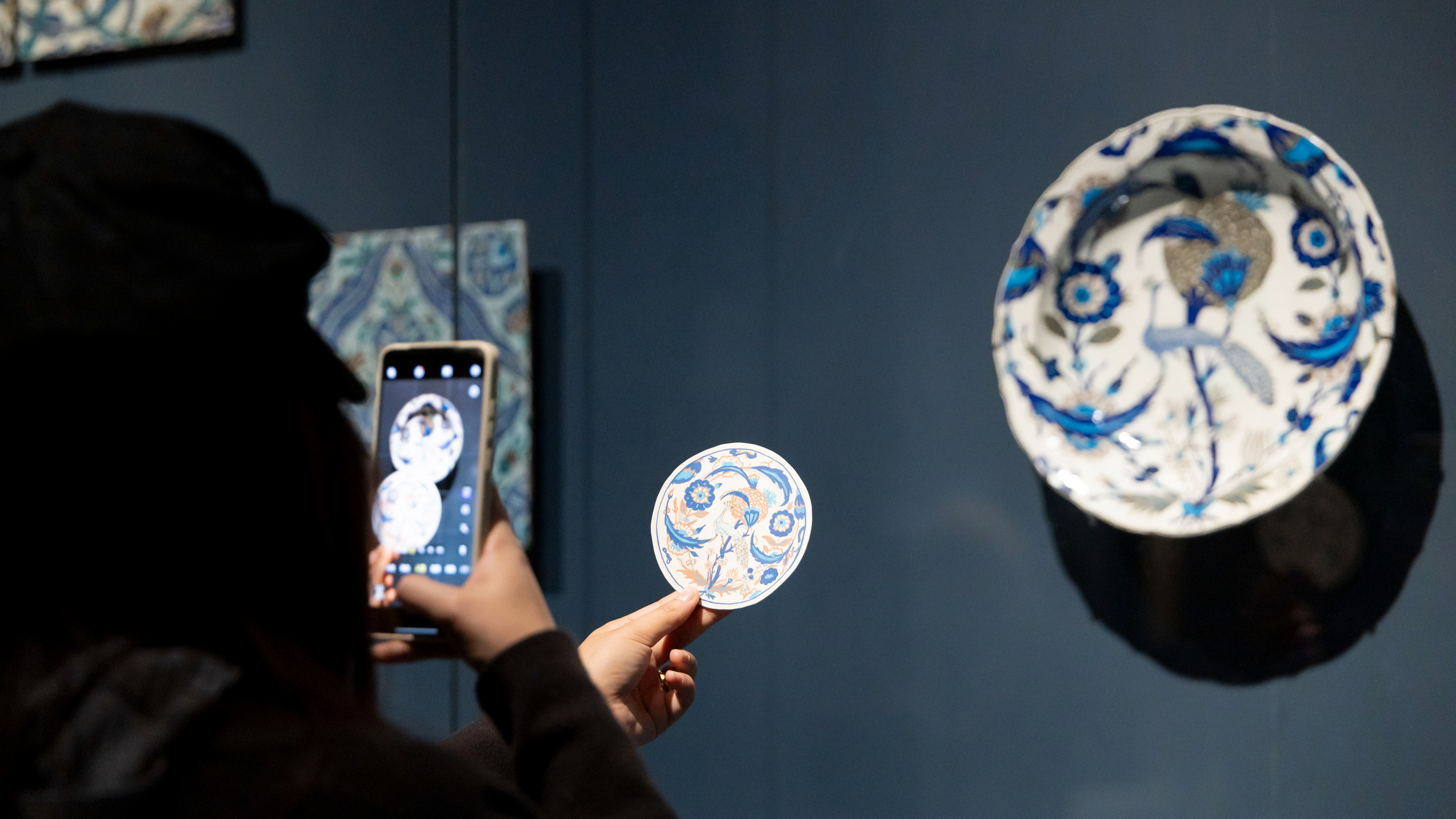
Beauty is a healing force, not to mention the "beautiful realm".
On December 28, the opening ceremony of the annual closing exhibition of Shanghai Pudong Art Museum, "A Realm of Absolute Beauty: Treasures from the National Archaeological Museum of Naples" was held. The collection of about 70 items from the National Archaeological Museum in Naples, Italy, and the ancient Roman civilization more than 2,000 years ago, presents the power of pure beauty.
In the solemn, majestic, and imitation of Roman architecture, the journalists of The Paper felt as if they were in a beautiful place more than 2,000 years ago. At that moment, Ling Dong, the epidemic, and the tragedy faded away.
The Paper learned that the exhibition "A Realm of Absolute Beauty" is the first large-scale cooperation between the National Archaeological Museum of Naples and a Chinese modern and contemporary art institution. It is a display of ancient Roman civilization more than 2,000 years ago. Many of the Italian national treasure exhibits in the exhibition are participating in overseas exhibitions for the first time.

Marble of Asclepius, 2nd century AD, National Archaeological Museum of Naples, Rome

Exhibition site, the ground is "Lion and Bacchus Procession Scene Mosaic", stone mosaic, 1st century BC, Pomme, National Archaeological Museum of Naples; the wall is "Stucco Ceiling", stucco, AD 1st century, Vesuvius site, Naples National Archaeological Museum
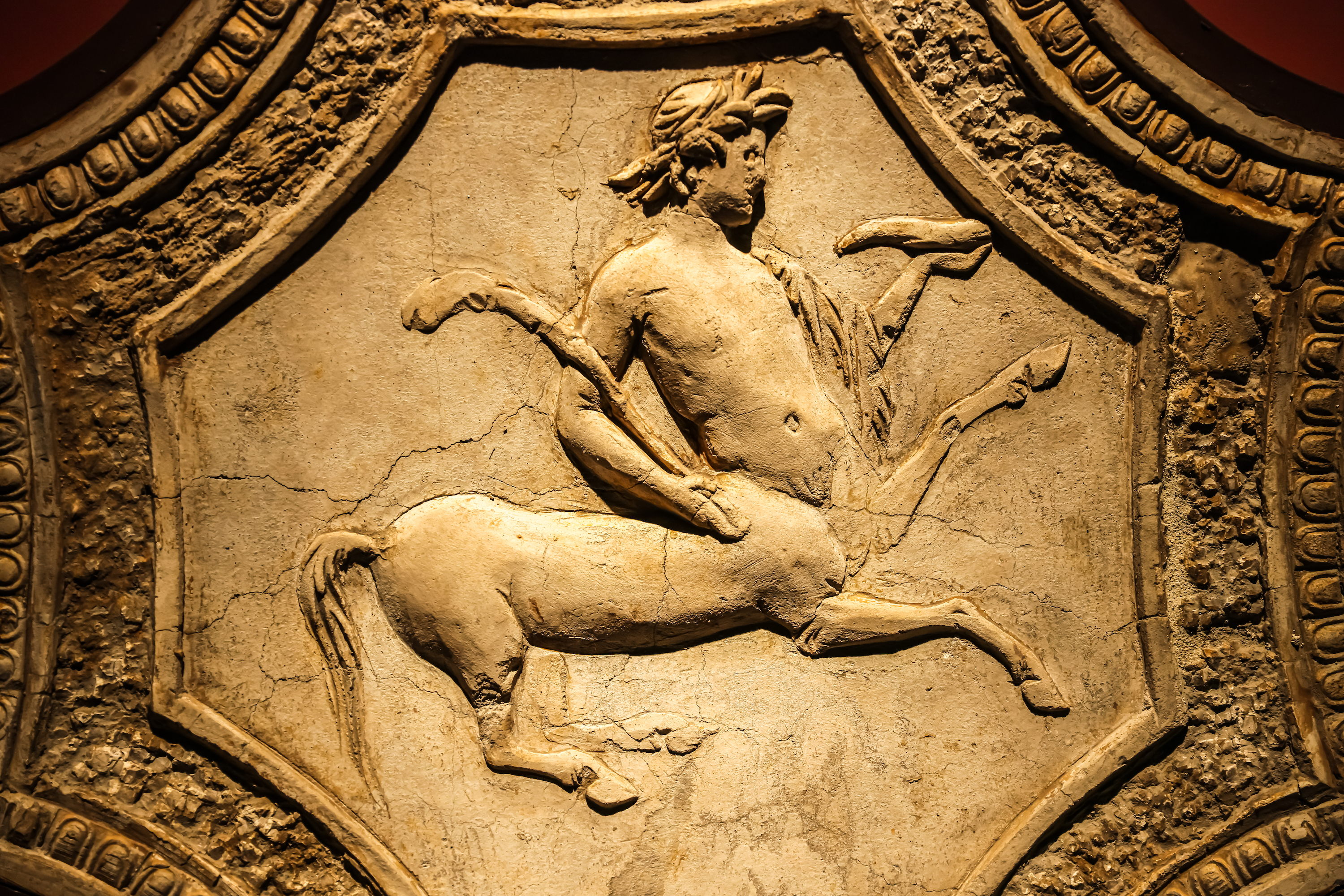
"Stucco Ceiling"
The National Archaeological Museum of Naples is a world-class museum of antiquities, housing antiquities from Pompeii, Herculaneum and Stabia, as well as a series of collections from the Farnese collection. The exhibition is located in the exhibition halls on the first and third floors of Pudong Art Museum. It is divided into three units according to different themes: "Love and Beauty", "Power and Beauty" and "Home and Beauty". The exhibits include sculptures, mosaics, murals, Various forms of artworks such as bronzes and glass products reproduce the splendid civilization of ancient Rome from different aspects, and illustrate that "beauty" is an eternal experience beyond definition.
beauty, seduction and conquest
Aphrodite in Greek mythology is the Venus in the Roman population. The god of love and beauty endows all things in the world with attractiveness. Bent Aphrodite and Eros is a 2nd century Roman marble sculpture depicting Venus crouching on a bath stand. The ancient Greek sculptor Prakmetelles used the downward curl of the goddess's body to express beauty. Earlier, this idea originated from the works created by the sculptor Dudarsas of Bithynia (now Turkey) for the royal family. It was very popular during the Roman period and was widely used to decorate villas and palace gardens.

"Bending Aphrodite and Eros" Marble 2nd century AD, collection of the National Archaeological Museum of Naples, Rome
In "Reclining Aphrodite", the head of the goddess Venus is covered, and a hooded cloak covers her robes, creating a "rainy day" atmosphere. The goddess leans against the column, exuding the charm of S shape.

"Reclining Aphrodite" Marble 2nd century AD, National Archaeological Museum of Naples, Rome
Beauty is not only love and temptation, but also adventure and conquest. The 2nd-century marble sculpture "Amazonian Warrior on Horseback" is an example, which freezes the moment when an Amazonian woman falls from her mount. The sculpture adopts traditional portraiture, with the female warrior's right breast exposed and a shield on her right arm.

"Amazon Warrior on Horseback" Pentelicus Hill marble 2nd century AD, collection of the National Archaeological Museum of Naples, Rome
Stunning, fresco and bronze
A set of painted murals is amazing. Different from the oil paintings in general exhibitions, time has faded the anger of the murals, and the pictures have precipitated the taste and style of extreme tranquility and shining beauty.
Whether it is an ancient Roman villa or a public building, it is decorated with gorgeous interiors, where light, shadow and color are intertwined, mosaics, murals and various exquisite daily utensils are each beautiful.
The 1st-century painted mural "Tragedy Mask" from Pompeii has a more solemn and harmonious effect; "Sphinx Standing on the Edge of the Tapestry" has gone through years of baptism, and the colors are still bright, flashing the immature, natural, simple and pure art Beautiful; "Necklace Pendant with Images of the Gods" is a 1st-century mural in Herculaneum, depicting the faces of three men, but their appearance is still slightly inferior to that of "Nasos". Sisos and his reflection have flowed for two hundred centuries, and they are still beautiful out of the frame. And "Women Offering Tribute and Statues" and "Still Life with Dionysus Statues and Tribute Plates" show the ancients' accurate grasp of material forms.
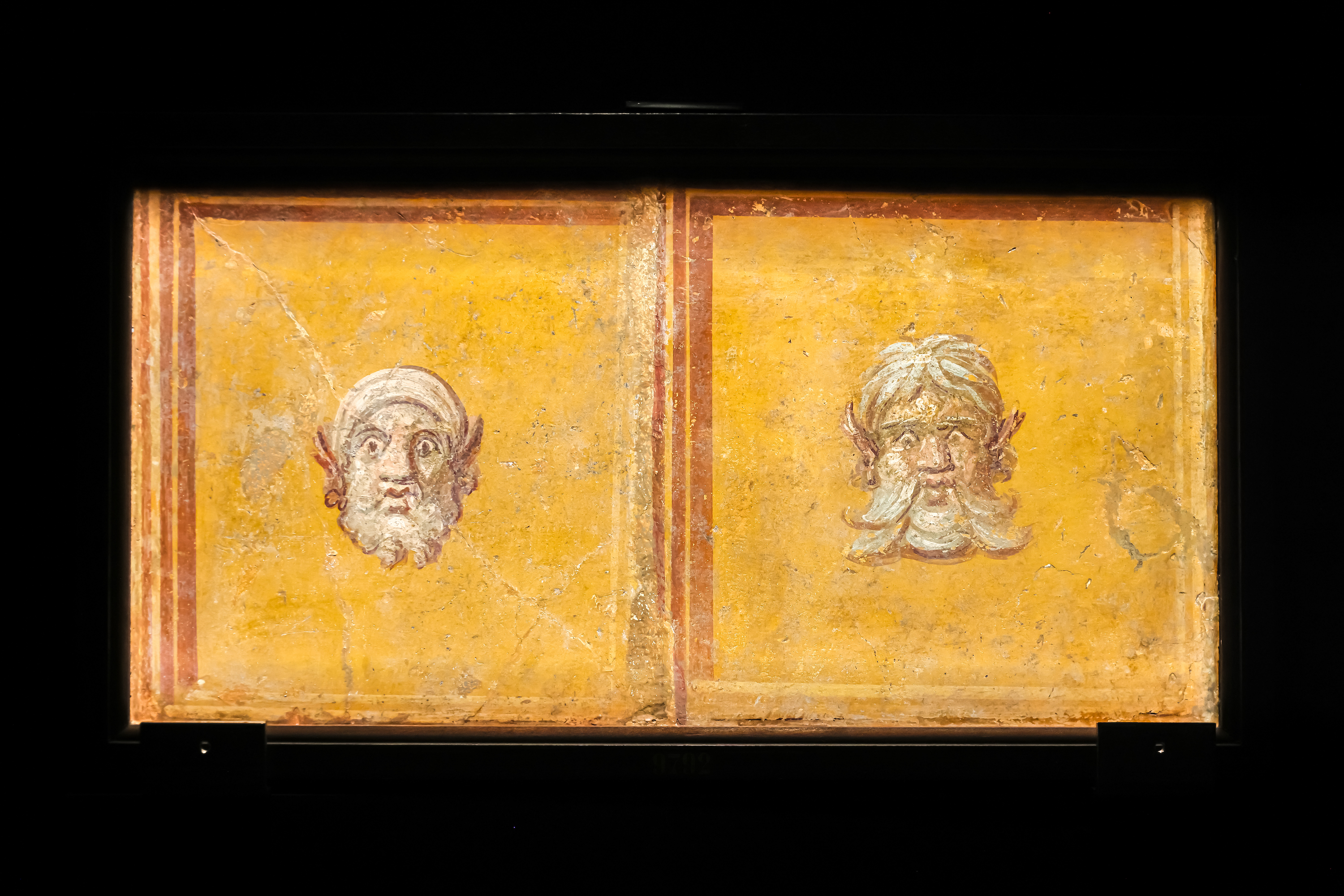
"Tragedy Mask" painted mural, 1st century AD, in the collection of the National Archaeological Museum of Naples, Pomme

"The Sphinx Standing on the Edge of the Tapestry" (Pangma Fresco Third Style) painted mural, 1st century AD, Pomme, National Archaeological Museum of Naples
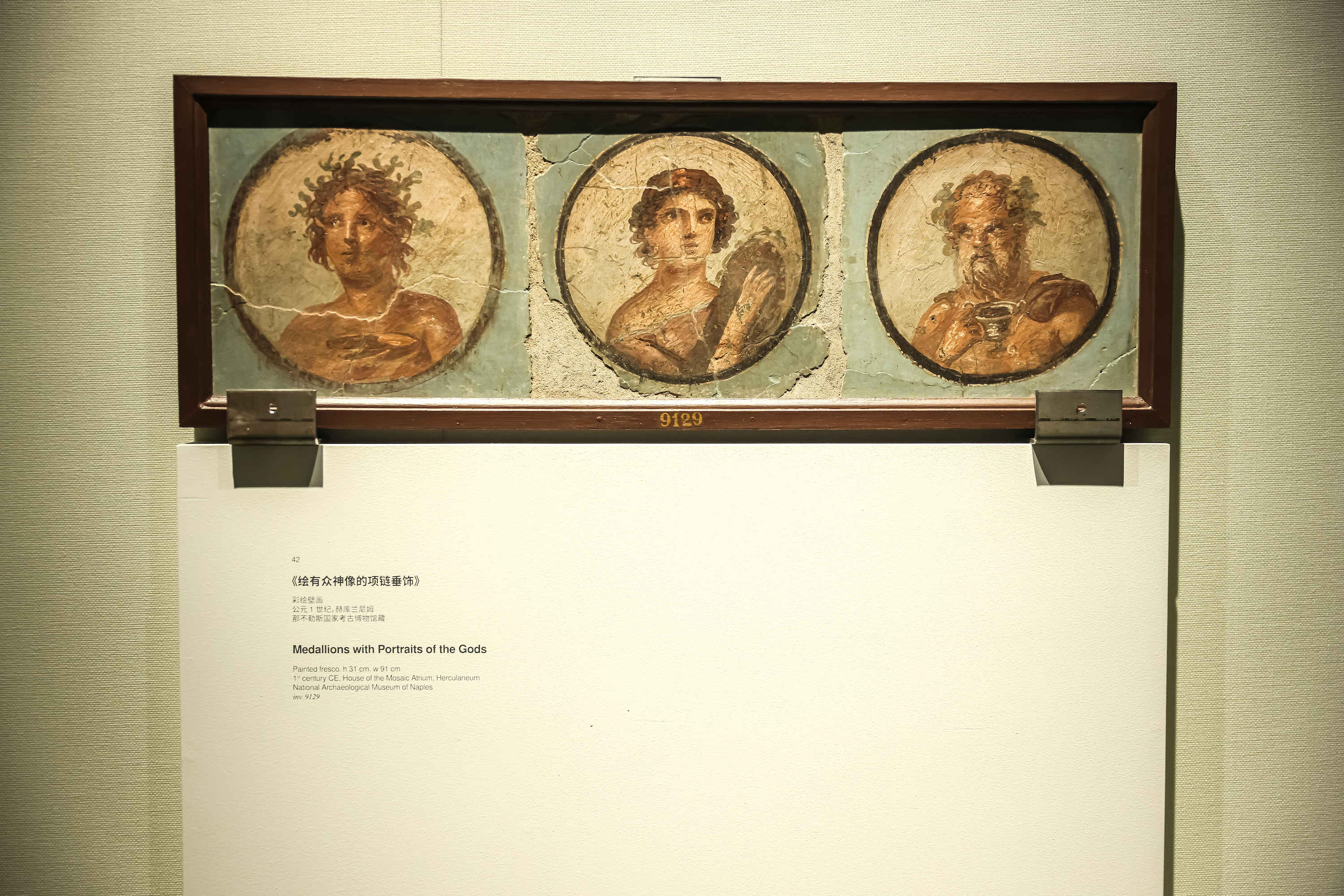
"Necklace Pendant with Images of the Gods" painted mural, 1st century AD, collection of the National Archaeological Museum of Naples, Herculaneum

"Namisos" painted fresco, 1st century AD, Pomme, National Archaeological Museum of Naples

"Still Life with Bacchus Statue and Tribute Plate" painted fresco, 1st century AD, collection of the National Archaeological Museum of Naples, Herculaneum

"Women Offering Tribute and Statues" painted mural, 1st century AD, collection of the National Archaeological Museum of Herculaneum, Naples
In the exhibition, there are some interesting comparisons. A map of "The Roman Empire and the Han Dynasty in China" reminds the imagination of the ancient Chinese and the Romans. In the eyes of the Romans, "Si people (Latin: Chinese in the North) are taller than ordinary people, red-haired and blue-eyed, live and work in peace and contentment, and full of sense of justice. Their life expectancy is as long as 140 years. According to legend, the entire ethnic group only drinks water. (tea)." In the eyes of the Chinese, the Romans "were all grown up and upright, similar to China, so they were called Daqin."
Compared with Chinese bronzes, which mainly function as ritual vessels, ancient Roman bronzes have various shapes. As early as in Pompeii in the 1st century, people would use "Folding Tripod"; "Shell Baking Mold" showed the taste of "Living Home"; the slender "Lampstand" told the craftsmanship of old craftsmen; Helmet" and "Warrior's Helmet" show off the strength of the conqueror.

"Folding Tripod" Bronze 1st century AD, collection of the National Archaeological Museum of Naples, Pomme

"Thrace Gladiator Helmet" Bronze 1st century AD, collection of the National Archaeological Museum of Naples, Pomme
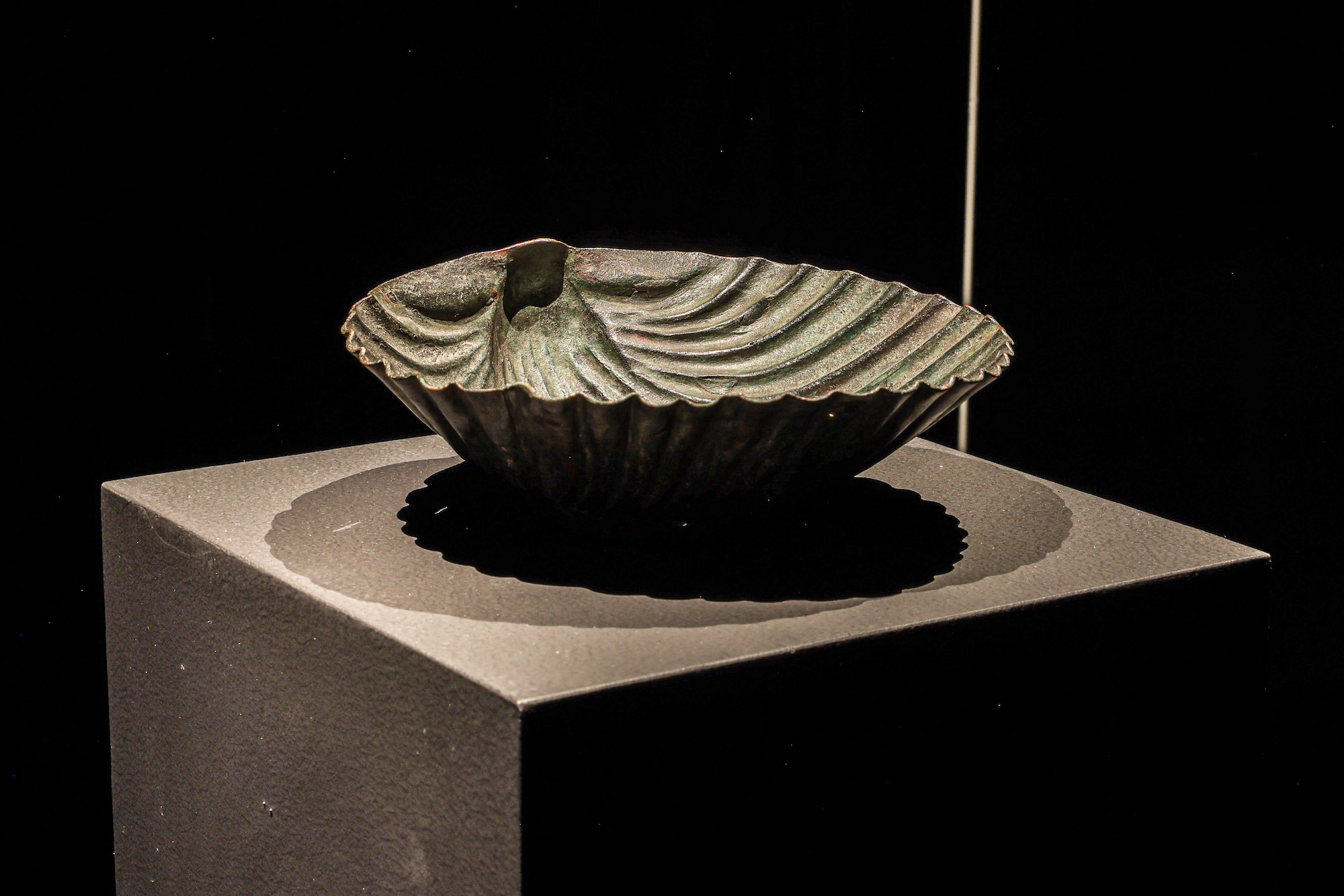
Shell Baking Mold, Bronze, 1st century AD, National Archaeological Museum of Naples, Pomme

"Two-mouth Oil Lamp with Lion's Head" Bronze 1st century AD, collected by the National Archaeological Museum of Naples, Pomme
What the current Chinese audience needs most may be the bronze Statue of the Patron Saint of the Family and the Statue of Isis, the Patron Saint of Fortune unearthed from the site of Mount Vesuvius. The figurines guard the big world, freeing all living beings from misery and embracing happiness.

"Family Patron Statue" Bronze 1st century AD, National Archaeological Museum of Naples at the site of Mount Vesuvius
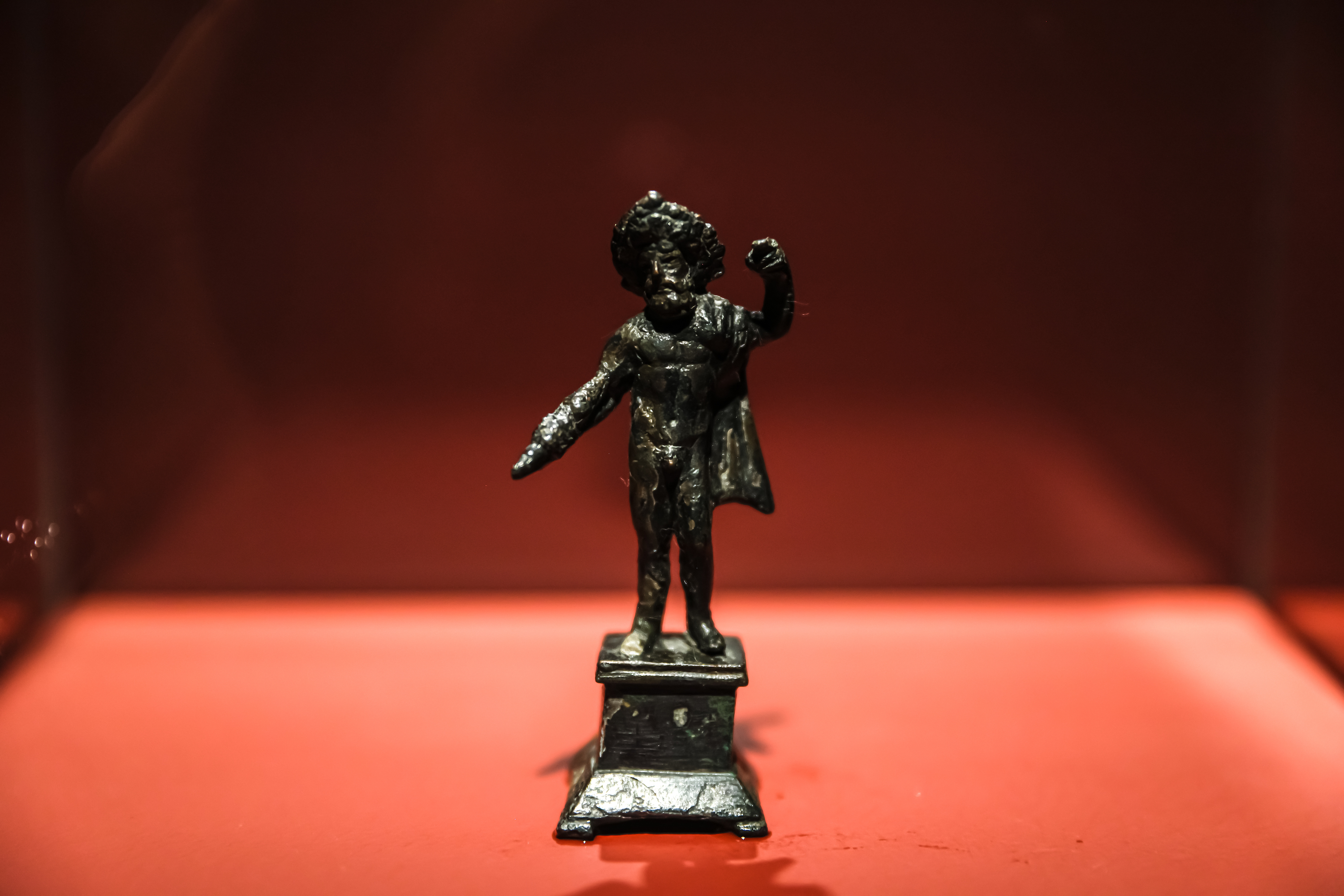
Statuette of Hercules, Bronze, 1st century AD, Herculaneum, National Archaeological Museum of Naples
One of the most famous sculptures on display is the Pseudo-Seneca Head (Pirate), which depicts a gaunt man who appears to be a Stoic scholar, in line with a long-standing ideal Its creative tradition was favored over the realist representations common in Roman art. In fact, Seneca's real appearance is a typical image of a rich man. He is fatter than his peers, and his real appearance does not match the philosophical ideal of Stoicism in his works.
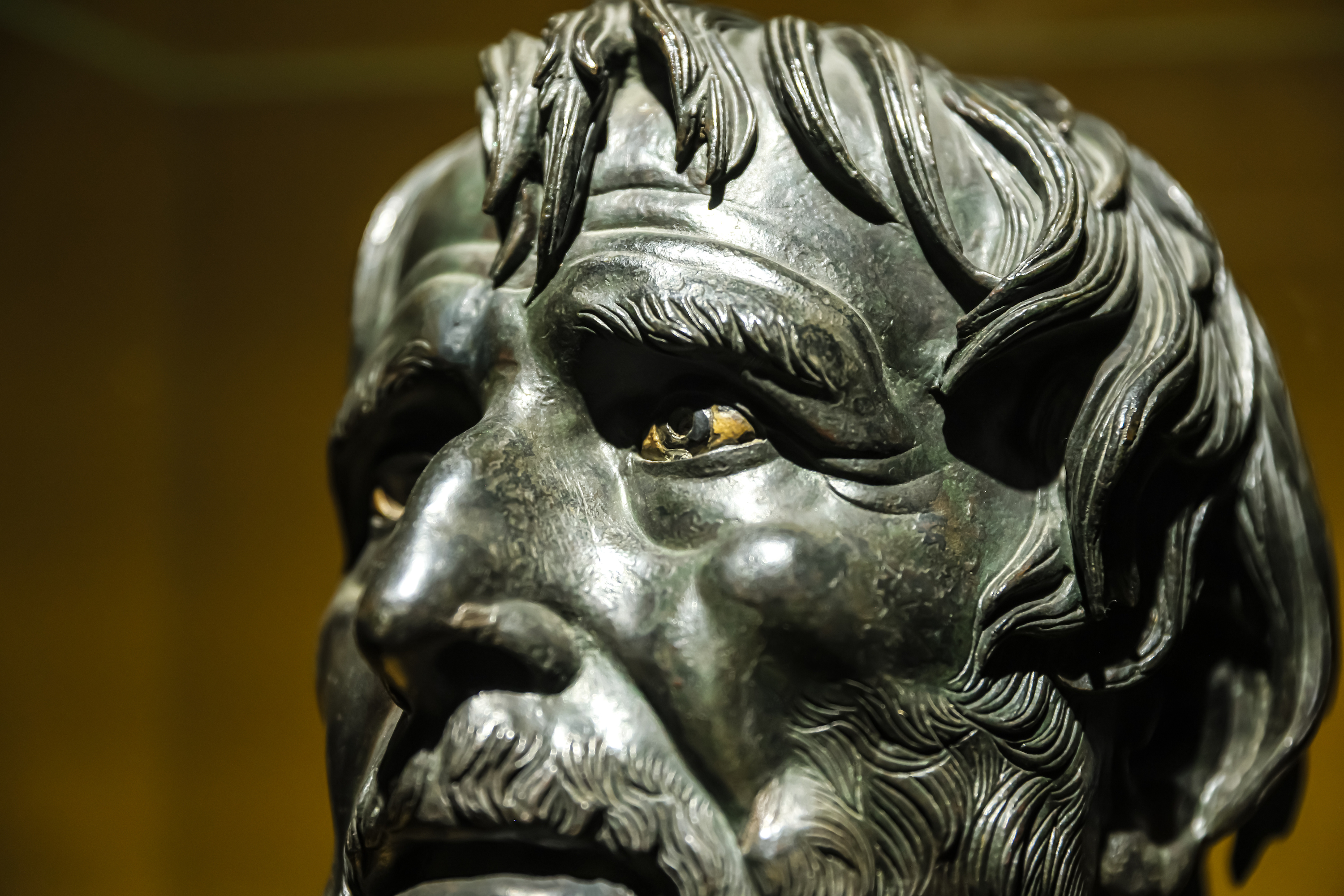
"Pseudo-Seneca Head" (pirate) bronze (detail)
1st century AD, National Archaeological Museum of Herculaneum, Naples
goddess, concept of beauty
Walking around the exhibition hall, you will be surrounded by marble reflecting ancient memories.
Marble sculptures were often used to decorate ancient Roman public buildings and noble villas, and they were the most vivid way to express the concept of beauty in that era. The sculptures of the gods such as Diana, Athena, Apollo, and Venus outlined the archetypes of beauty, and later became the inspiration for the secular expressions of the gods, such as the royal female beauty displayed in the cottage Grand Via.
A group of juxtaposed high ceilings of "Da Via in the Cabin", "Diana, the Goddess of Light" and "Athena" lead the audience to another climax of the exhibition. Diana in the center attracted many eyes with her light skirt.
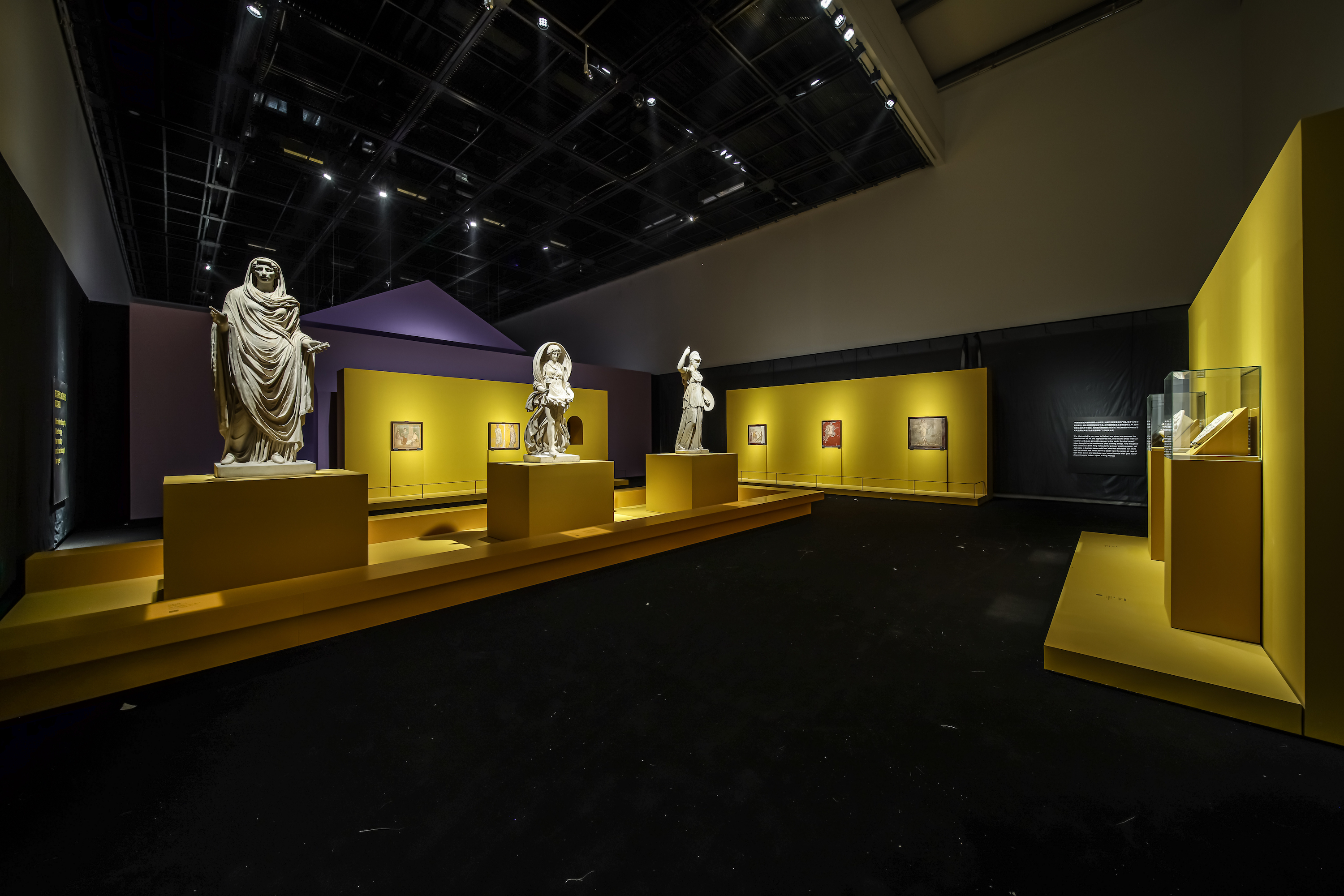
(From left) "Little Via", "Diana", "Athena"

Diana, Goddess of Light, Paros marble, 2nd century AD, source unknown, National Archaeological Museum of Naples

Part of "Diana, Goddess of Light"
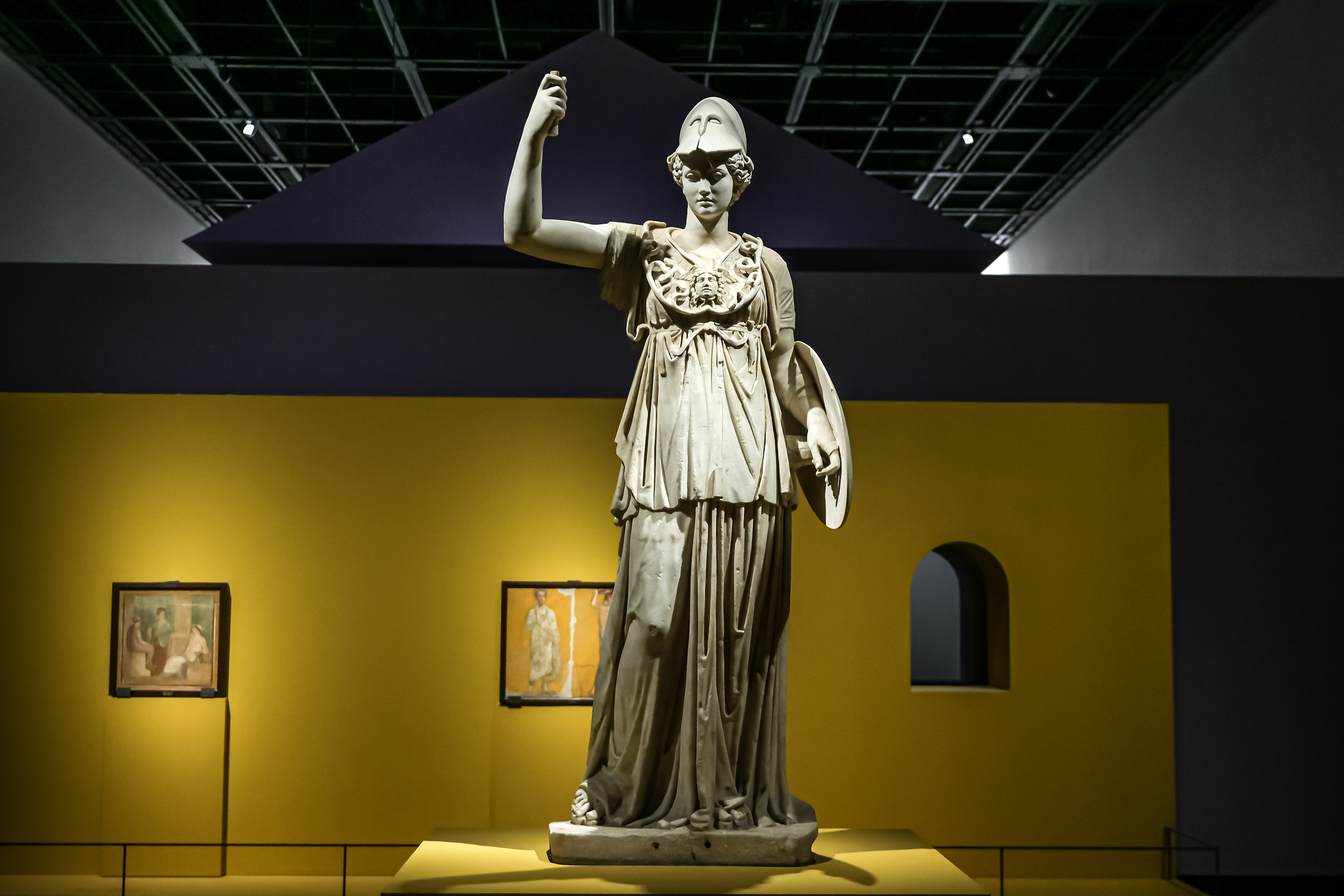
"Athena" Paros marble 2nd century AD, National Archaeological Museum of Naples, Rome
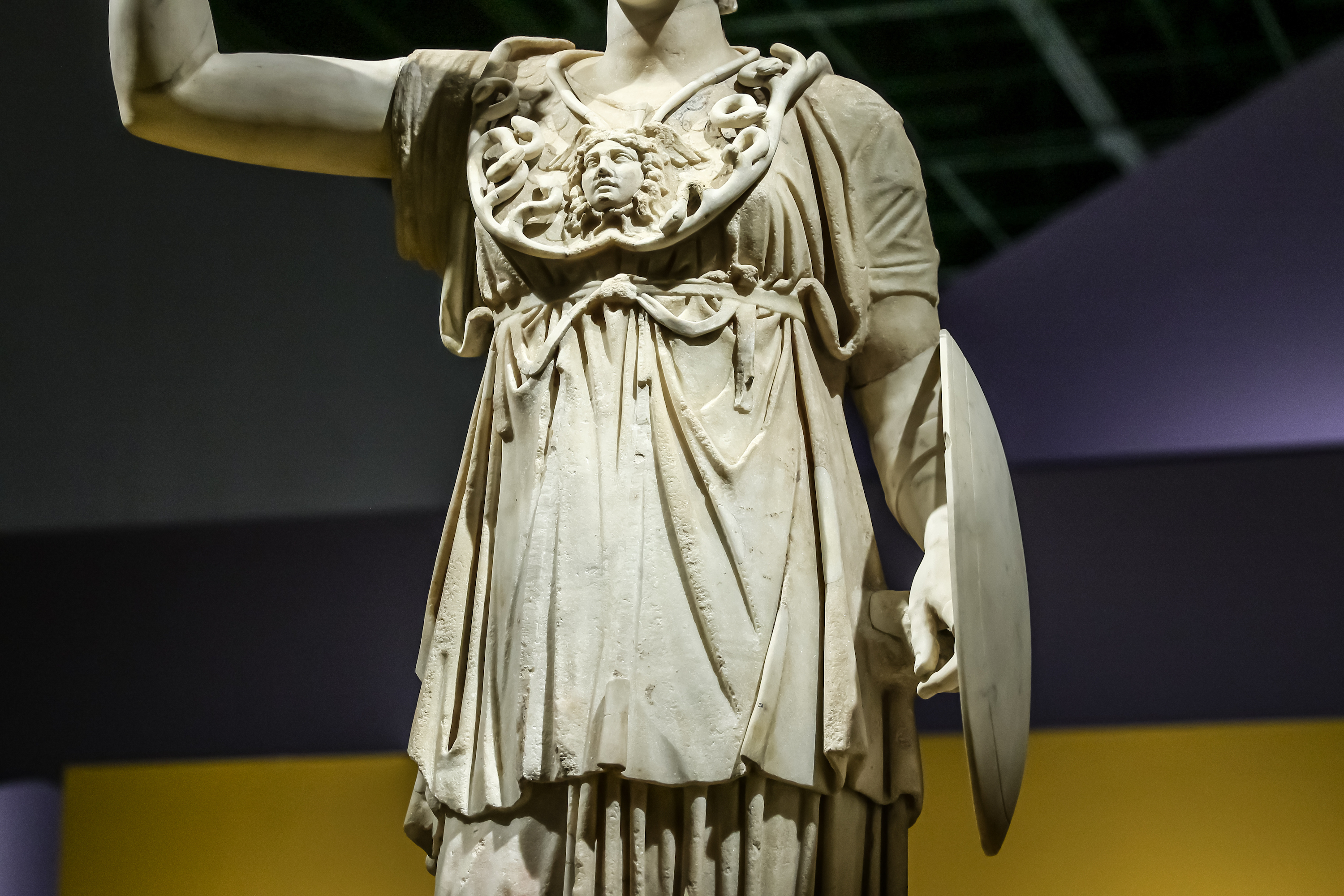
Part of "Athena"
Although the sculpture is often identified as Diana, the goddess of light, it could also be seen as Selene, the goddess of the moon. Following the traditional image, the sculpture shows the goddess descending to the ground with her cape raised high. The iconic scene of the goddess descending before her beloved Endymion has been reenacted countless times in the Ponte frescoes and is the source of this sculpture, whose right-hand torch was part of an early modern restoration.
The large-scale sculpture, because of the light "arched open window", makes the audience enjoy the viewing pleasure of moving and changing scenes. The 2nd century marble sculpture "The Back of Venus" faces Diana and Athena through the "open window".
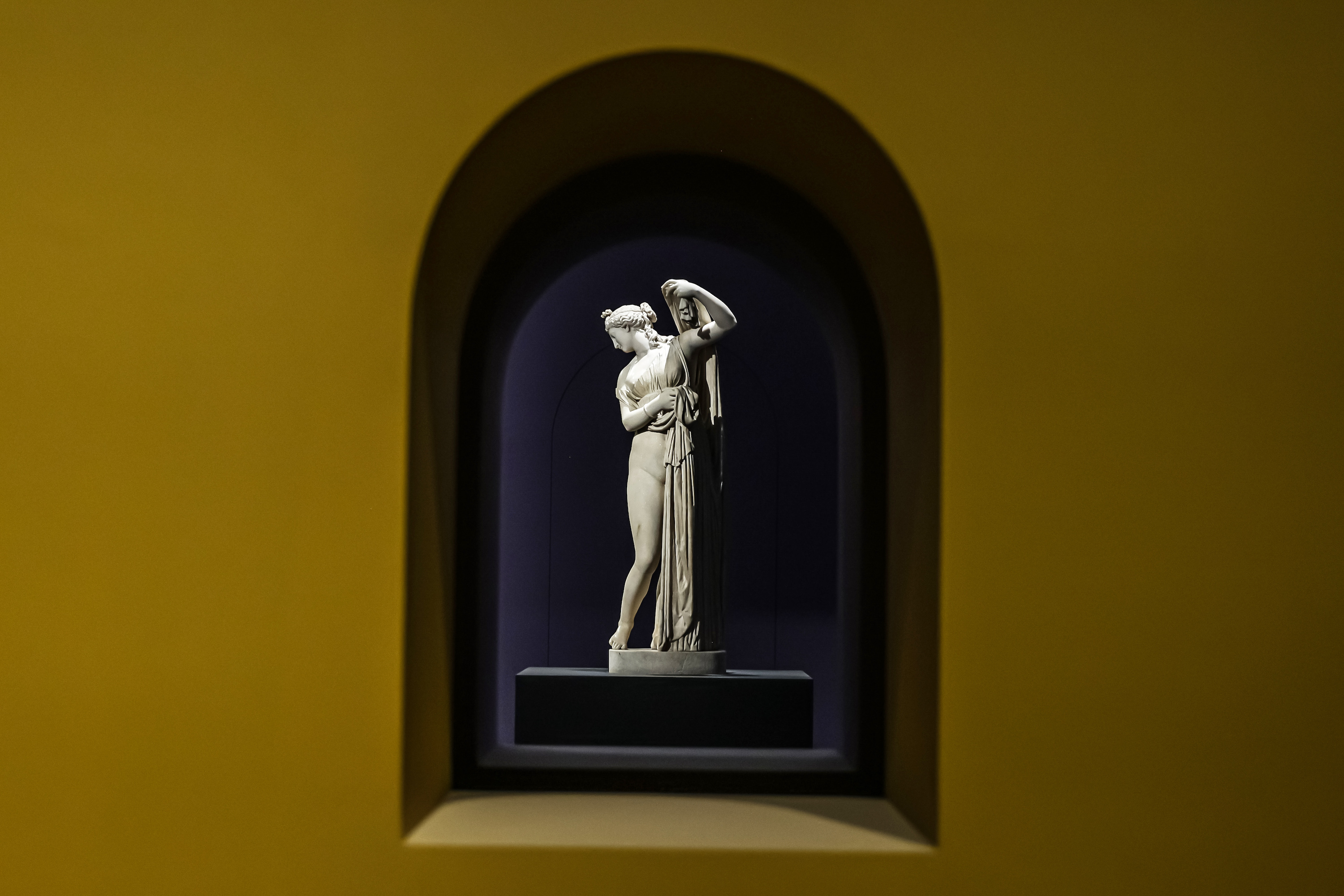
"The Back of Venus" marble 2nd century AD, collection of the National Archaeological Museum of Naples, Rome

(Left) "Apollo Holding a Sitar" Wadi Hammamet Greywacke; (Right) "The Back of Venus" Marble
2nd century AD, Rome, National Archaeological Museum of Naples
Venus shows the goddess raising her robe before bathing. Both embody the natural beauty of the goddess' physical form and imply her satisfaction with that beauty, as she is admiring her own reflection in the water. This sculpture embodies the unique vision of sculptor Prakistelles, which sees the relationship between humans and nature from a new perspective.
In the water city of Venice, Italy, there is the world-famous Glass Island with beautiful glass products. But when the audience leans close to the showcase and stares at the glass "jug", "relief glass" and glass "bottle" from the ruins of Mount Vesuvius and Pompeii under the spotlight, an "ideal of beauty" leaps in front of them.

"Jar" glass 1st century AD, in the collection of the National Archaeological Museum of Naples at the site of Mount Vesuvius

"Double Handle Engraved Cup" and "Relief Glass" (right) glass, 1st century AD, collection of the National Archaeological Museum of Naples, Pomme

exhibition site
At the end of the exhibition is a video work. The eye of the camera, the portal of contemporary art, surveys the deepest halls of Roman palaces, where the marble surfaces of ancient sculptures still glow in the darkest places.
After 70 beautiful visual baptisms, it may be difficult for the audience to continue to absorb the beauty of modern images. They smiled knowingly at the last paragraph of text on the exhibition wall——
"Beautiful, shimmering gleam, only light can meet your eyes."

exhibition site
"A Place of Absolute Beauty: Treasures from the National Archaeological Museum of Naples"
Exhibition period: 2022.12.21-2023.4.9
Venue: Shanghai Pudong Art Museum
